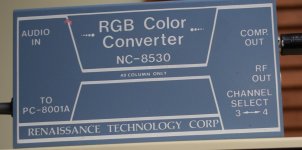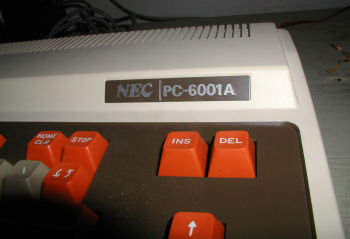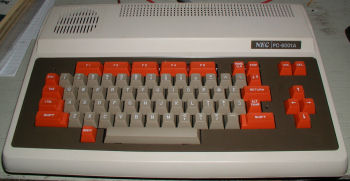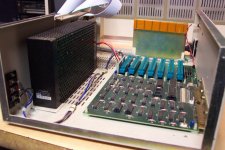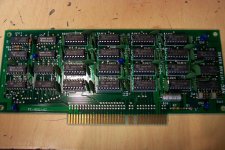The PC-8001(A) has two DIN video ports: monochrome composite and color RGB.
The composite port uses the same pin for video as the Dragon 64, so luckily the video cable I use for my Tano Dragon works fine. But be careful -- the pin that the Dragon uses for audio output, the NEC has +12 volts DC coming out of! (The NEC only has a little beeper built in, and no audio output.)
The color output is 8-color 15 kHz analog RGB (quite advanced for a computer introduced in 1979!). With the right cable, it would work with my Commodore 1084 monitor, or my Mitsubishi Diamond Scan AUM-1381A.
Hi,
I hooked my PC-8001BE up to an oscilloscope this evening to take a look at the video outputs. I used the pin-outs as per the old-computers.com site, these seemed to be correct when looking at the back of the computer facing the sockets.
The black & white output was fairly normal, +0.7V to -0.3V (1V p-p). The vertical/frame rate is 60Hz and the horizontal/line rate is 15.75kHz, so this is standard NTSC. This is not common in europe (PAL specifies 50Hz / 15.625kHz) so I will need a NTSC-type monitor. Most mono monitors can be adjusted to 60Hz but not all.
The color sockets were quite odd. These socket has:
V sync = 60Hz negative going pulses (16.7ms between pulses, TTL levels, 0V to 4.1V)
H sync = 15.75kHz negative going pulses (63us between pulses, TTL levels, 0V to 4.1V)
Color clock = 14.3MHz (ie 4 times the NTSC 3.579545MHz color carrier), positive going pulses (70ns between pulses, from -2V to +8V)
RGB = waveform going from -8V to +16V (24V p-p)
As the power on screen is mostly blank the RGB signals are long periods of 0V with short bursts of signal. Not sure why the voltage goes over such a large range, maybe it is designed for some sort of terminating network (eg a 1kohm resistor in series feeding a 100 ohm resistor to ground would give 2V p-p, or a 150 ohm resistor in series feeding a 75ohm input)?
Also both video sockets have a +12V pin for powering modulators (or turning on monitors).
I would be wary of connecting the color output straight into a prized multisync monitor without checking it out first.
Maybe vwestlife could open up his RGB to composite converter and have a look at the RGB input?
I found a similar adapter (well NEC computer RGB in to component video out) here:
http://tulip-house.ddo.jp/digital/DIGITAL_RGB_COMPONENT/english.html
Regards,
John

